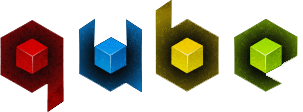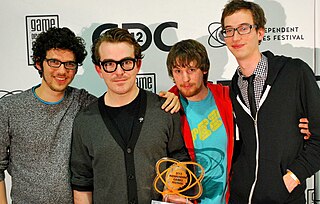A programming game is a video game that incorporates elements of computer programming, enabling the player to direct otherwise autonomous units within the game to follow commands in a domain-specific programming language, often represented as a visual language to simplify the programming metaphor. Programming games broadly fall into two areas: single-player games where the programming elements either make up part of or the whole of a puzzle game, and multiplayer games where the player's automated program is pitted against other players' programs.
Emergent gameplay refers to complex situations in video games, board games, or table top role-playing games that emerge from the interaction of relatively simple game mechanics.

An indie game, short for independent video game, is a video game created by individuals or smaller development teams without the financial and technical support of a large game publisher, in contrast to most "AAA" (triple-A) games. Because of their independence and freedom to develop, indie games often focus on innovation, experimental gameplay, and taking risks not usually afforded in AAA games. Indie games tend to be sold through digital distribution channels rather than at retail due to a lack of publisher support. The term is synonymous with that of independent music or independent film in those respective mediums.

Limbo is a puzzle-platform video game with horror elements developed by independent studio Playdead and originally published by Microsoft Game Studios for the Xbox 360. The game was released in July 2010 on Xbox Live Arcade, and has since been ported by Playdead to several other systems, including the PlayStation 3, Linux and Microsoft Windows. Limbo is a 2D side-scroller, incorporating a physics system that governs environmental objects and the player character. The player guides an unnamed boy through dangerous environments and traps as he searches for his sister. The developer built the game's puzzles expecting the player to fail before finding the correct solution. Playdead called the style of play "trial and death", and used gruesome imagery for the boy's deaths to steer the player from unworkable solutions.

ProtoGalaxy is a cross-genre video game for Microsoft Windows that was released on October 6, 2010. In the game's back-story, a species of powerful, unknown extraterrestrials enters the Milky Way with the intention of enslaving its inhabitants. The player characters must defend Earth from this alien threat and restore human civilization. ProtoGalaxy is a 2.5D game; the 2D playing field employs 3D graphics. ProtoGalaxy incorporates elements of a variety of gaming genres, such as adventure, arcade, shooter, puzzle, and role-playing genres.

The Potato Sack is the name of an alternate reality game (ARG) created by Valve and the developers of thirteen independent video games to promote the release of Valve's game Portal 2, in April 2011. Valve president Gabe Newell envisioned the game as a "Cross Game Design Event" in December 2010, and allowed the developers free rein to design the game using Valve's Portal intellectual property. The game, requiring players to find and solve a number of puzzles hidden within updates of the thirteen games, led to the opportunity for players to release Portal 2 about 10 hours earlier than its planned release by playing games under the pretense of powering up GLaDOS, the sentient computer antagonist from the Portal series. The ARG's theme of potatoes is based on plot elements within Portal 2, specifically that for part of the game, GLaDOS's personality module is run off a potato battery.
Zachtronics LLC is an American video game developer, best known for engineering-oriented puzzle video games and programming games. Zachtronics was founded by Zach Barth in 2000, who serves as its lead designer. Some of their games include SpaceChem, Infinifactory, TIS-100, and Shenzhen I/O. Infiniminer (2009) inspired the creation of Minecraft.

Atom Zombie Smasher is a real-time strategy game developed by independent developer Blendo Games. In it, the player attempts to rescue as many citizens as possible from an oncoming zombie horde using helicopter rescue units and an array of military units to protect the citizens and defeat the zombies.

Q.U.B.E. is a physics-based puzzle video game developed and published by Toxic Games, with help from Indie Fund, a group of independent game developers. The game, an expansion of a student project by the founding members of Toxic Games, was released for Microsoft Windows through a number of digital distribution platforms, first through Desura on 17 December 2011 and then through Steam on 6 January 2012. An OS X port was later released on 17 December 2012 through Steam and on 18 December 2012 through Desura.
Blendo Games is an American independent video game development company based in Culver City, California. It was founded by Brendon Chung in 2010 and is primarily a one-person effort. Blendo Games gained more widespread exposure with the short form stand alone title Gravity Bone; the following games Flotilla and Atom Zombie Smasher were met with critical praise. The studio has also released several other games in several genres.
Early access, also known as alpha access, alpha founding, paid alpha, or game preview, is a funding model in the video game industry by which consumers can purchase and play a game in the various pre-release development cycles, such as pre-alpha, alpha, and/or beta, while the developer is able to use those funds to continue further development on the game. Those that pay to participate typically help to debug the game, provide feedback and suggestions, may have access to special materials in the game. The early-access approach is a common way to obtain funding for indie games, and may also be used along with other funding mechanisms, including crowdfunding. Many crowdfunding projects promise to offer access to alpha and/or beta versions of the game as development progresses; however, unlike some of these projects which solicit funds but do not yet have a playable game, all early access games offer an immediately playable version of the unfinished game to players.

The high-profile and protracted five-year development of the video game Fez led to its status as an "underdog darling of the indie game scene". The 2012 puzzle-platform game built around rotating between four 2D views of a 3D space was developed by indie developer Polytron Corporation and published by Polytron, Trapdoor, and Microsoft Studios. Over the course of the game's development, Fez designer and Polytron founder Phil Fish received celebrity status for his outspoken public persona and prominence in the 2012 documentary Indie Game: The Movie, which followed the game's final stages of development and Polytron's related legal issues. The game was released to critical acclaim as an Xbox Live Arcade timed exclusive, and was later ported to other platforms. It had sold one million copies by the end of 2013.
Infinifactory is a puzzle video game developed and published by Zachtronics, initially released on Microsoft Windows, OS X, and Linux on June 30, 2015. The game was later released on PlayStation 4 in December 2015. In the game, the player takes the role of a human abducted by aliens and forced to construct assembly lines to create certain objects for apparently-nefarious purposes. The game combines elements of Zachtronics' previous SpaceChem and Infiniminer, with the assembly lines being built from blocks in a three-dimensional space.
TIS-100 is a programming/puzzle video game developed by Zachtronics Industries. The game has the player develop mock assembly language code to perform certain tasks on a fictional, virtualized 1970s computer that has been corrupted. The game was released for Microsoft Windows, OS X, and Linux personal computers in July 2015.

Shenzhen I/O is a puzzle video game and programming game developed by Zachtronics for Microsoft Windows, Linux, and macOS-based personal computers. The game was released in November 2016.

Sokobond is a puzzle video game created by Alan Hazelden and Harry Lee. Gameplay involves moving atoms around 2D grids to form chemical compounds. The game was released on Linux, OS X, and Windows in August 2013. It was later released for Nintendo Switch in September 2021, and iOS and Android in May 2022. The game received generally favorable reviews from critics.

Opus Magnum is a puzzle-based programming game developed by Zachtronics. It was released for Microsoft Windows, Linux, and Mac in December 2017, following about two months of early access. In the game, the player must assemble a series of machines using various tools and program them to complete alchemy-related tasks. The player can advance with any working solution to each problem, but is challenged through leaderboards to produce a machine that does the task in the shortest time, with the lowest cost of materials, and/or the smallest occupied area. Opus Magnum is based on The Codex of Alchemical Engineering, one of the earliest Flash games made by Zach Barth prior to establishing Zachtronics.
Exapunks is a programming game developed by Zachtronics. It was released into early access on August 9, 2018, and fully released on October 22, 2018.

Eliza is a visual novel game developed by Zachtronics, released on Windows, macOS, and Linux on August 12, 2019, with a Nintendo Switch version on October 10, 2019.













